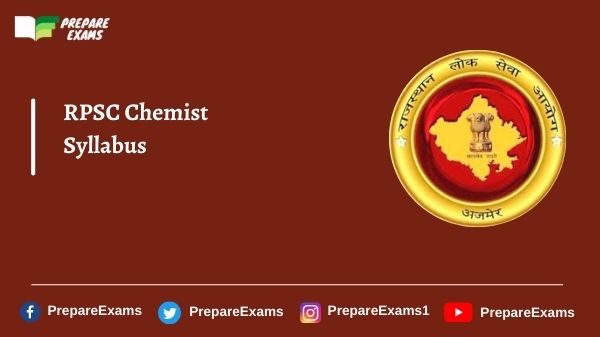RPSC Chemist Syllabus PDF Download – In this article, students will find the RPSC Chemist Exam Syllabus PDF direct links, RPSC Chemist Exam Pattern 2022, RPSC Chemist Selection Process, and so on.
RPSC Chemist Syllabus 2022 – Overview
| Board Name | Rajasthan Public Service Commission (RPSC) |
| Posts | Chemist |
| Selection Process | Written Exam |
| Category | Syllabus |
| Job Location | Rajasthan |
| Official Website | rpsc.rajasthan.gov.in |
RPSC Chemist Exam Pattern 2022
RPSC Chemist Exam Pattern 2022 Written Examination Paper will be an objective type paper. you will be asked 150 questions in the exam and each question carries one mark. There will be total marks for the exam of 150 Marks including a negative marking of 1/3rd for every wrong answer.
- Total Question – 150 Questions
- Total Marks – 150 Marks
- Exam Duration – 2 Hours 30 Minutes
- Language –
- Mode of Exam – Objective Choice Questions
- Negative Marking – Yes, 1/3 Marks
Questions related to Subject
- General Chemistry
- Basic Organic Chemistry
- Reaction Mechanism
- Name Reactions
- Stereochemistry
- Analytical Techniques
- Chromatography
- Spectroscopy
- Biomolecules
- Drugs and Their Applications
| Also Read: |
| RPSC Chemist Previous Question Papers PDF Download |
| RPSC Chemist Admit Card |
| RPSC Chemist Answer Key |
| RPSC Chemist Results |
| RPSC Chemist Exam |
RPSC Chemist Syllabus 2022
| RPSC Chemist Syllabus 2022 & Exam Pattern PDF Download | Click Here |
General Chemistry
- Ionization energy, electron affinity, electronegativity, ionic, covalent, coordinate, hydrogen bond, Vander Wall forces, Valence Bond Theory, hybridization, shapes of simple inorganic and organic molecules, VSEPR theory, introduction to Molecular Orbital Theory (MOT) of homo-nuclear and heteronuclear diatomic molecules.
Basic Organic Chemistry
- Inductive effect, resonance, hyper-conjugation, isomerism, organic functional groups and their identification tests and nomenclature of organic compounds. Structure and important properties of alkanes, alkenes, alkynes, alcohols, aldehydes, ketones, carboxylic acids, amines, benzene, phenols, naphthalene, anthracene, furan, pyrole, pyridine and thiophene.
Reaction Mechanism
- Types of reagents and reaction intermediates, free radicals, nucleophiles, electrophiles, carbonium ions, carbanions, nitrene, carbene, benzyne, substitution, addition, elimination
- and rearrangement reactions and aromaticity.
Name Reactions
- Aldol Condensation, Baeyer – Villiger oxidation, Birch reduction, Diels – Alder reaction, Friedel-crafts reaction, Haloform reaction, Claisen-Schmidt reaction, Hofmann elimination, Mannich reaction, Pinacol-Pinacolone rearrangement, Reformatsky reaction, Reimer-Tiemann reaction and Wittig reaction.
Stereochemistry
- Stereochemistry and conformational analysis of organic compounds, D-L notation, R-S notation, E-Z system of nomenclature, conformations of alkanes and cycloalkanes, optical activity and racemisation.
Analytical Techniques
- Volumetric titrimetry (redox, complexometric and acid-base titrations), gravimetric analysis, Karl-Fischer method, potentiometric titrations, conductometric titrations and
partition coefficient. - Evaluation of analytical data- significant figures, precision, accuracy, errors, mean, median, mode and standard deviation.
Chromatography
- Principle, instrumentation and applications of the following:
- a) Thin layer chromatography
- b) Paper chromatography
- c) Ion exchange chromatography
- d) Gas chromatography
- e) High performance liquid chromatography
Spectroscopy
- Principle and applications of UV-Visible, IR, Mass and NMR spectroscopy in structure
- elucidation.
Biomolecules
- Structure, classification and applications of molecules of biological importance –
- carbohydrates, amino-acids, proteins, enzymes, lipids, steroids, alkaloids, terpenoids and
- flavonoids.
Drugs and Their Applications
Drugs in the prevention and treatment of diseases under following category:
(i) Cardiovascular drugs – Propranolol, Furosemide
(ii) Antibiotics- Penicillin, Tetracycline
(iii) Anti-malarial- Chloroquine, Primaquine
(iv) Anti-pyretic and analgesic- Aspirin, Paracetamol
(v) Anti-diabetic drugs- Insulin, Metformin
(vi) Anti-tubercular – Isoniazid, Rifampicin
(vii) Anticancer drugs- Doxorubicin, Paclitaxel
(viii) Drugs acting on CNS: Barbiturates, Phenothiazines
★★★★ You Can Also Read ★★★★
| Computer Awareness Quiz Questions Set (Banking) |
| Read Daily Current Affairs Topic Wise |
| Daily Current Affairs Quiz (Current GK Test) |
| Static Gk Quiz Questions and Answers |
📣 Prepare Exams is now on Facebook, Twitter, Instagram, YouTube Channel, and Google News to get all the latest News first Like, Follow and bookmark our website @ PrepareExams.com.
For all the latest Updates, download PrepareExams App.


